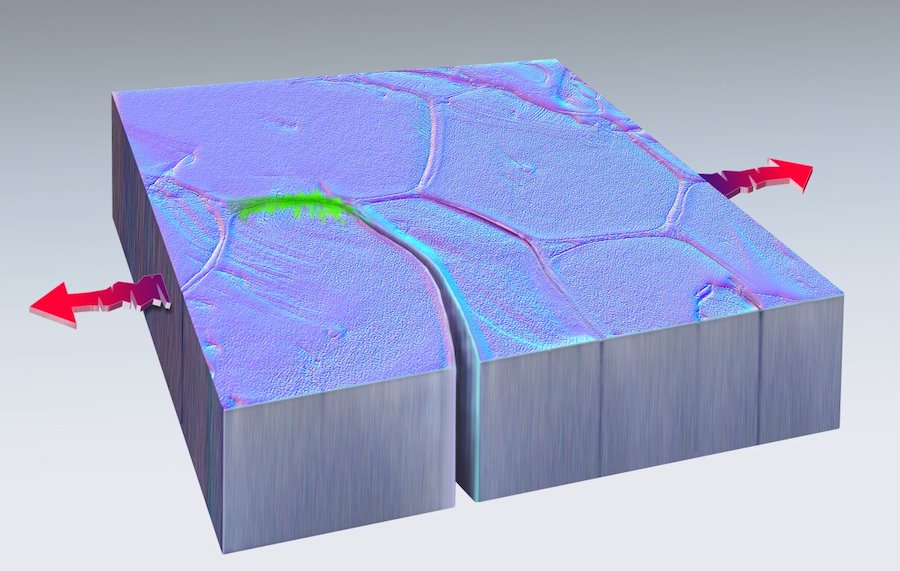Self-healing metals may revolutionize engineering – study
Staff Writer | July 26, 2023 | 6:06 am Suppliers & Equipment USA Copper Platinum

(Reference image by David R. Ingham, Wikimedia Commons.)
"Recent research by a team at the Sandia National Laboratories and Texas A&M University describes, for the first time, how pieces of metal crack, then fuse back together without any human intervention, overturning fundamental scientific theories in the process.
According to the researchers, if the newly discovered phenomenon can be harnessed, it could usher in an engineering revolution—one in which self-healing engines, bridges and airplanes could reverse damage caused by wear and tear, making them safer and longer-lasting.
In a paper published in the journal Nature, the scientists explain that they were able to confirm that metals have their own intrinsic, natural ability to heal themselves, at least in the case of fatigue damage at the nanoscale.

Artistic rendering of nanoscale self-healing in metal,Artistic rendering of nanoscale self-healing in metal. Red arrows indicate the direction of the pulling force that unexpectedly triggered the phenomenon. (Image by Dan Thompson, Sandia National Laboratories).
Fatigue damage is one way machines wear out and eventually break. Repeated stress or motion causes microscopic cracks to form. Over time, these cracks grow and spread until about the whole device breaks.
In detail, Brad Boyce and his team saw a fissure disappear that was one of these tiny but consequential fractures—measured in nanometers.
“From solder joints in our electronic devices to our vehicle’s engines to the bridges that we drive over, these structures often fail unpredictably due to cyclic loading that leads to crack initiation and eventual fracture,” Boyce said.
“When they do fail, we have to contend with replacement costs, lost time and, in some cases, even injuries or loss of life. The economic impact of these failures is measured in hundreds of billions of dollars every year for the US.”
Although scientists have created some self-healing materials, mostly plastics, the notion of a self-healing metal has largely been the domain of science fiction.
“Cracks in metals were only ever expected to get bigger, not smaller. Even some of the basic equations we use to describe crack growth preclude the possibility of such healing processes,” the researcher said.
Reversing damage
In 2013, Michael Demkowicz—then an assistant professor at the Massachusetts Institute of Technology, now a full professor at Texas A&M—began chipping away at conventional materials theory. He published a new theory, based on findings in computer simulations, that under certain conditions metal should be able to weld shut cracks formed by wear and tear.
The discovery that his theory was true came inadvertently at the Center for Integrated Nanotechnologies, a Department of Energy user facility jointly operated by Sandia and Los Alamos national laboratories.
“We certainly weren’t looking for it,” Boyce said.
Khalid Hattar, now an associate professor at the University of Tennessee, Knoxville, and Chris Barr, who now works for the Department of Energy’s Office of Nuclear Energy, were running the experiment at Sandia when the discovery was made. They only meant to evaluate how cracks formed and spread through a nanoscale piece of platinum using a specialized electron microscope technique they had developed to repeatedly pull on the ends of the metal 200 times per second.
Surprisingly, about 40 minutes into the experiment, the damage reversed course. One end of the crack fused back together as if it was retracing its steps, leaving no trace of the former injury. Over time, the crack regrew in a different direction.
Boyce, who was aware of the theory, shared his findings with Demkowicz.
“I was very glad to hear it, of course,” Demkowicz said. The professor then recreated the experiment on a computer model, substantiating that the phenomenon witnessed at Sandia was the same one he had theorized years earlier.
Still a way to go
A lot remains unknown about the self-healing process, including whether it will become a practical tool in a manufacturing setting.
“The extent to which these findings are generalizable will likely become a subject of extensive research,” Boyce said. “We show this happening in nanocrystalline metals in a vacuum. But we don’t know if this can also be induced in conventional metals in air.”
Yet for all the unknowns, the discovery remains a leap forward at the frontier of materials science.
“My hope is that this finding will encourage materials researchers to ... "
https://www.mining.com/self-healing-met ... ing--study